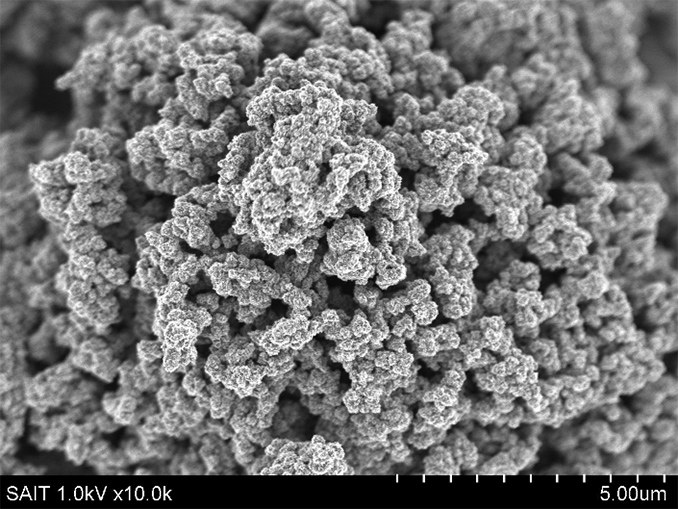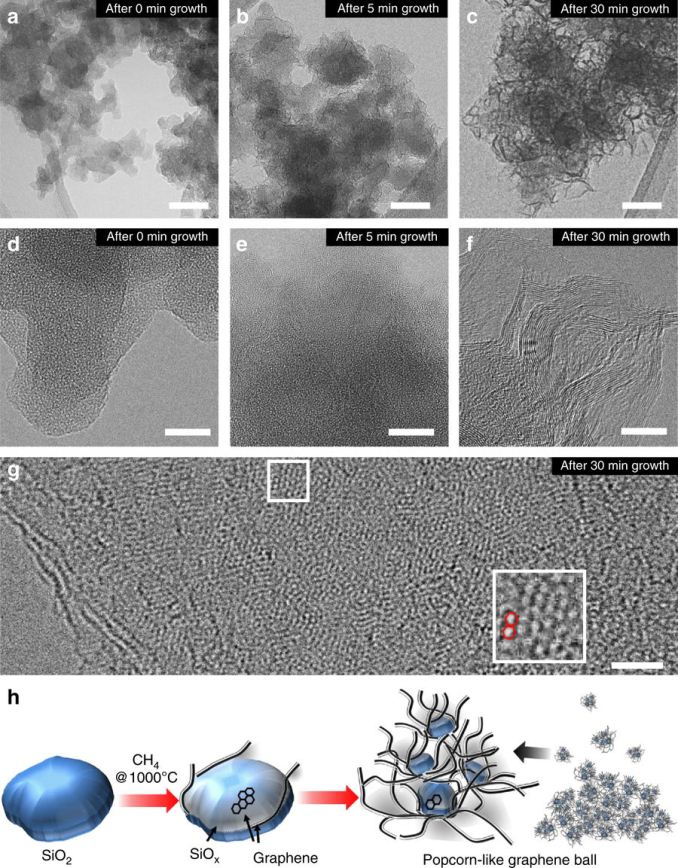Samsung’s Reveals Li-Ion Battery with Graphene Balls: Higher Capacity, Faster Charging
by Anton Shilov on November 29, 2017 5:00 PM EST- Posted in
- Mobile
- Samsung
- Battery
- Samsung SDI
- Graphene

Samsung on Tuesday announced that it had developed a way to improve Lithium-Ion batteries with its new material called graphene balls. The company says that batteries featuring the new material charge five times faster than conventional Lithium-ion accumulators and enable a considerably higher volumetric energy density.
The new battery technology developed by Samsung SDI and its partners* uses the so-called graphene balls (a 3D structure synthesized from silicon dioxide, Si02) to cover a cathode and also as an anode material. Graphene balls on the cathode suppress damaging side reactions while also providing efficient conductive pathways. This enables faster charging (as graphene features 140 times faster electron mobility than silicon) and increases the number of cycles a cell can withstand. According to Samsung, a battery cell featuring graphene balls has a 27.6% higher volumetric energy density compared to a similar cell without graphene balls. Furthermore, the cell also retains 78.6% of its capacity after 500 cycles at between 5°C and 60°C.
Samsung articulates that graphene balls could enable batteries with up to 45% higher capacities (than contemporary batteries) that can charge in 12 minutes – or five times faster than today’s batteries, as Samsung puts it. However, what Samsung is not saying when it intends to use the technology for commercial applications. Incorporation of a new protective layer for cathode and switching anode material changes battery production technology, which generally affects costs. Meanwhile, Samsung claims that the graphene ball material is not expensive to produce using its new chemical vapor deposition (CVD) process. To grow graphene around SiO2 nanoparticles with diameters of 20–30 nm, Samsung feeds them into a furnace and feds methane (CH4) into it at 1000°C.
“Our research enables mass synthesis of multifunctional composite material graphene at an affordable price,” said Dr. Son In-hyuk, who led the project on behalf of SAIT*. “At the same time, we were able to considerably enhance the capabilities of lithium-ion batteries in an environment where the markets for mobile devices and electric vehicles is growing rapidly. Our commitment is to continuously explore and develop secondary battery technology in light of these trends.”
Samsung expects to use its Li-ion batteries featuring graphene balls for electric vehicles and various mobile devices. Since the improved batteries can handle temperatures of around 60°C, they are a good fit for both applications. The most important question is of course when exactly Samsung SDI plans to commercialize them. To that end, it is noteworthy that earlier this year an unnamed executive from Samsung SDI told a newspaper that the company would be able to produce solid-state batteries for smartphones sometimes in 2019.
*The new battery technology was co-developed by Samsung SDI (the company’s battery arm), Samsung Advanced Institute of Technology (SAIT) as well as Seoul National University’s School of Chemical and Biological Engineering.
Related Reading:











45 Comments
View All Comments
jjj - Wednesday, November 29, 2017 - link
LOL the quality of the press...You completely misrepresent this and paint it as an actual product as opposed to research. This is research and there are such breakthroughs every week if not every day. Vast majority will never make it into an actual product.
You also only cover this because it's Samsung and not because it's more relevant that any of the 100 others battery papers published in the last 5 minutes.
This is not journalism.
coburn_c - Wednesday, November 29, 2017 - link
It was covered because Samsung put out a press release.Ryan Smith - Wednesday, November 29, 2017 - link
And because Samsung is in a unique position as a vertically integrated device manufacturer, meaning they have the option of putting this into commercial use of their own products, if they desire.Samus - Wednesday, November 29, 2017 - link
I agree. It wouldn't be out of the question for them to launch this technology in a niche release, like a mid-range phone, perhaps even a submodel of an existing phone, that could have, say, a week of power. Think Galaxy S Active, etc.I don't see them taking a risk with new battery technology in a mainstream device after the Note 8. I also don't see them launching this in devices where it's needed most, wearables, where realestate is at a premium so any improvement in energy density is highly desirable, again because of the risk factor.
juhatus - Thursday, November 30, 2017 - link
The first products they mass produce and use these new battery technologies are those chargeable 10-20$ usb-power batteries that can charge tablets/phone's on the go. They can make a batch of millions with very little image risk if something goes wrong. Hey its noname 10$ usb-brick, not a 800$ phone.coburn_c - Thursday, November 30, 2017 - link
I feel I need to clarify:Pipeline stories are regurgitated press releases. This is not an article. Most of the press these days is regurgitated press releases. This is not Anandtech's fault.
Five times faster charging with only 22% degradation after 500 charges is excellent. Most current cells lose 20% after 500 charges without fast charging.
ddrіver - Wednesday, November 29, 2017 - link
This is just AT using copy/paste on what PR departments from different companies send out.Morawka - Wednesday, November 29, 2017 - link
Unlike everyone else Samsung has the willingness and need to implement this, have working prototypes inside of phones, and have peer reviewed research plus a patent pending application. I wouldn't be surprised if this technology is in next year's S9CaedenV - Wednesday, November 29, 2017 - link
Not saying you are wrong, but Samsung is in the somewhat unique position of owning its own research and manufacturing arms. That certainly does not guarantee that it will get deployed in the real world... but it certainly makes for far fewer barriers between research and production. Also, Sammy has a pretty good reputation of not really announcing things unless it intends to use it, unless something better comes along to replace it before implementation.That said; I really wonder how much of those improvements are purely from this one improvement, or if these improvements are for a mythical battery that has this as well as many other 'expected improvements'.
Still, battery tech is improving rapidly, and with lots of competition. The nice thing about the CPU wars of the '90s and '00s was that there were only 3-4 major players (Intel, AMD, IBM, and lets not forget VIA's chips of 'biblical renown'), and so chip makers felt safe building large fabs to produce lots of chips on a regular basis. With battery tech there are several players, and everyone is playing these cat and mouse games where nobody really wants to gear up a particularly large fab for fear of needing to re-tool too quickly (or be out done by someone who builds a fab 3 months later). It really makes the space interesting to watch, but also delays mass-market products and adoption.
Stuza - Thursday, November 30, 2017 - link
"The nice thing about the CPU wars of the '90s and '00s was that there were only 3-4 major players (Intel, AMD, IBM, and lets not forget VIA's chips of 'biblical renown'), "You forgot one of the major players, Motorola, powering Mac's, Atari ST's and Amiga's. :)